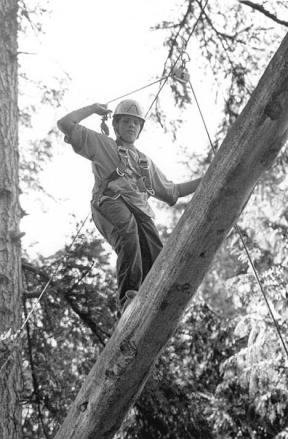The message on Ben Gilmore’s answering machine says, “The ropes challenge program is alive and getting well.”
That’s good news for all the schools, youth groups, leadership programs, community groups, the Navy and even businesses that use the extensive and popular ropes course. Over 15,000 people from Whidbey Island and all over the Puget Sound region have gone through the program in the last decade.
The challenge program was shut down last year after the county Health Department could do longer afford to support it because of budget cuts.
But then Island County / Washington State University Cooperative Extension stepped in. Don Meehan, extension director, said he simply couldn’t stand to see the popular course remain idle.
“We made the decision to take it on,” he said, “even though this office was also clobbered with budget cuts. I just didn’t want it to go away.”
Meehan’s main challenge was to find money. The ropes course was originally built on county parkland in 1993 as a joint venture between the Health Department and the extension office. The Health Department provided the majority of the funding, while the extension office oversaw the instructors, did safety inspections and handled liability issues.
Fortunately, Island Thrift came to the rescue by providing a $30,000 grant for the program. “They’ve given us a new lease on life,” Meehan said.
It was enough money to get the course up and running again. Gilmore, the manager of the program, said he’s already started it up again earlier this month. He’s scheduled groups and is looking for instructors.
Meehan, however, said there will have to be some changes and continuing support from the community to keep the program going for the long run. While he said the he wants to keep the fees reasonable, there will have to be increases, especially for adult groups.
In all, Meehan said he expects fees to generate about $10,000 a year. They also recently received a $1,000 donation from the Coupeville Lions. But it’s not enough to keep the program going in the long run, so Meehan said hopes to find more support from community groups and “corporate sponsors” — local businesses that may use the course and donate money.
Gilmore said the program is a perfect tool for businesses or any group interested in team building, improving communication, learning critical thinking or encouraging self-esteem.
“It has a lot to do with learning the power of a group,” he said. “Groups get better as communicating, inclusion and problem solving.”
The “challenge” idea was developed in the early 1970s by an organization called Project Adventure and is now used worldwide to help groups of all kinds interact successfully. It combines the ideas Outward Bound with ropes course activities.
Gilmore said there’s a common misconception that the program is all about swinging from ropes in the tops of trees and other scary stunts. In reality, there are only three high-altitude challenges, while the rest are much more down to earth.
The two-acre ropes challenge program is tucked away in a woods in Central Whidbey. The course is made up of more than a dozen elements or challenges that a group must figure out a way through, over or under. There’s the spider web made of ropes, for example, that a group has to get through without touching any of the ropes. There’s also a giant teeter-totter that a group has to balance themselves on.
Last summer Gilmore said Oak Harbor public works employees went through a version of the program and ended up having a good time. Instructors brought portable equipment to the public works facility in Oak Harbor.
In fact, Gilmore said the program can be tailored just about to any group. After all, one of the lessons it’s supposed to teach is the value of inclusion.



